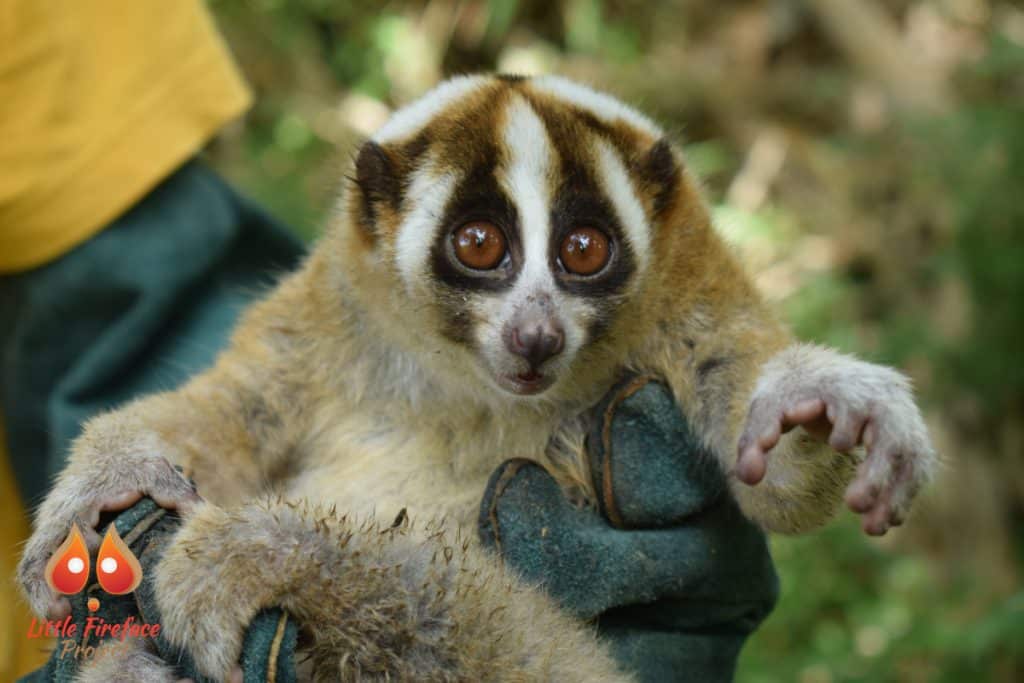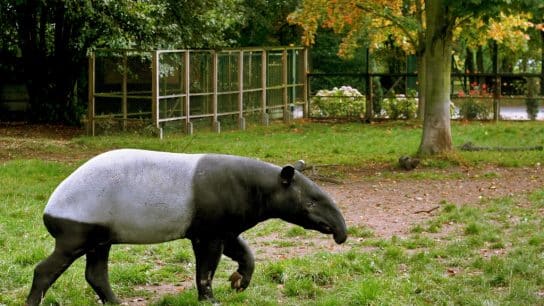One of nine species of slow loris, the Javan slow loris is a wide-eyed, nocturnal primate that inhabits the rainforests, bamboo forests, mangroves and plantations of Java, Indonesia. Known to be the only venomous primates, slow lorises have an array of unique evolutionary adaptations which, until recently, had been relatively understudied. Unfortunately, slow loris populations are rapidly declining throughout their range states due to habitat loss and the exotic pet trade – an issue that garnered widespread international attention in 2009 when videos of lorises being kept as pets emerged on social media platforms. Four species of slow loris are currently listed as Endangered under the IUCN Red List, two are listed as Vulnerable, and two (the Bangka and Javan slow lorises) are Critically Endangered.
—
| Family | Lorisidae |
| Genus | Nycticebus |
| Species | Nycticebus javanicus |
| IUCN Status | Critically Endangered |
| Population | Unknown |
1. Appearance
The Javan slow loris is the second-largest species of slow loris and the largest of the Indonesian slow lorises. Adults typically weigh between 570 and 690 grams (20-24 oz) and have an average body length of 29 centimetres (11 in).
The most striking feature of a slow loris is its large, globe-like, forward-facing eyes, which are specially adapted to their nocturnal lifestyle. Like many other animals, the slow loris has an additional layer of reflective tissue in the back of their eyes called the tapetum lucidum. Located behind the retina, this layer of tissue reflects light that enters the pupil so that it hits the light detecting cells of the eye twice. This adaptation helps enhance the nocturnal vision of slow lorises and creates a distinctive shine when light is pointed into their eyes.
The species has a distinctive brown dorsal stripe running up its spine and over the crown of its head, forking off to its ears and eyes. The vertical stripes then thicken to frame the animal’s large brown eyes, resulting in a white diamond-shaped pattern on its forehead. It is theorised that the dark rims around the animal’s eyes are an adaptation to make them appear bigger to predators, although others believe that the unique colouration of slow lorises is a form of Müllerian mimicry with spectacled cobras (this theory will be further explained below).

Their bodies are beige, light brown or reddish-brown in colour, and their fur is 2.2 to 2.8 centimetres (0.9-1.1 in) in length. Their arms and legs are long, with long, splayed fingers and toes for grasping vines and branches. The thumbs and big toes of a slow loris are located almost 180 degrees away from their other digits and are twice the width, providing the animal with an extremely tight grasp. Their index fingers and the second toe on each of their feet are greatly reduced in length and have longer nails than the rest of the digits. While these shortened index fingers serve to provide the hands with a pincer-like grasp, the second toes serve as grooming claws, or toiled claws, used to clean themselves.
Due to its unique form of locomotion, the slow loris is not as agile as other arboreal primates and does not need a long tail for balance. As a result, their vestigial tail is around 2.5 centimetres (0.9 in) long and concealed by fur.
2. Diet
Slow lorises are exudativores, consuming insects, reptiles, gum, nectar and sap. Fruit constitutes an limited portion of the species’ diet, as excessive amounts can cause obesity, diabetes and tooth decay. Furthermore, lorises produce their own vitamin C and do not need to obtain it from their diet. Exudates make up the majority of their daily intake. Slow lorises are frequently seen hanging by their feet so they are able to eat with both of their hands.
The bottom front teeth of slow lorises are a modified structure known as a tooth-comb, made up of four incisors and two canines. Although it is theorised that the tooth-comb found on lemurs and lorises originally evolved for fur-combing, subsequent modifications in numerous lineages resulted in both its morphology and function being altered. Slow lorises have been observed utilising the tooth-comb not only for grooming, but also for scraping tree gum and gouging holes in tree trunks.
Slow lorises also have a lengthy, narrow tongue to aid with reaching tree gum and flower nectar. A second tongue, known as the sublingua, lies below their primary tongue. Thin, pointed and whitish in colour, slow lorises use this secondary tongue to clean their tooth-comb of any tree bark, hair or debris.
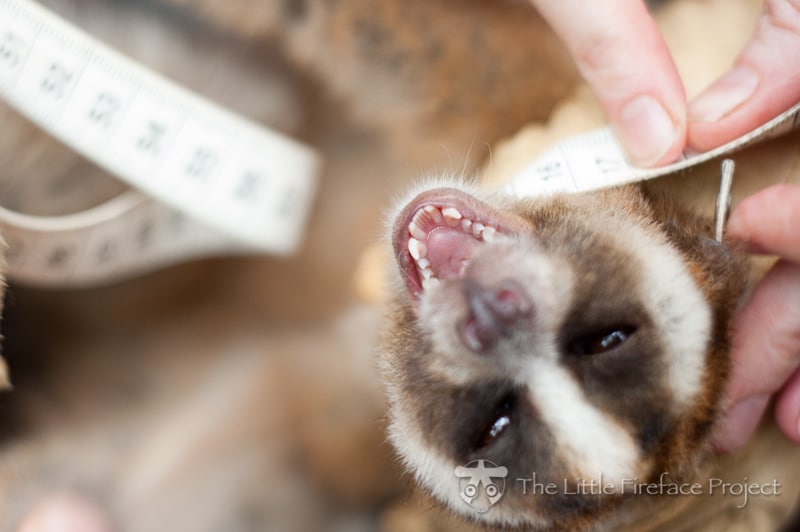
3. Habitat & Behaviour
The Javan slow loris was originally classified as a subspecies of the Sunda slow loris (Nycticebus coucang), but was taxonomically separated as its own species in 2008. The Javan slow loris occurs in secondary disturbed lowland to highland rainforests, primary forests, bamboo forests, mangrove forests, and plantations. The species has been found from the westernmost province of Banten to central Java, including in localities such as Ujung Kulon, Gunung Gede Pangrango, Meru Betiri, Gunung Tilu, Gunung Simpang, and Gunung Sawa. In East Java, it has been observed in Meru Betiri and Alas Purwo national parks, as well as Tumpang Pitu and Salakan forests. The species is believed to have occurred throughout the island of Java in the past, however it is estimated that a mere 20% of their historic habitat remains. Javan slow lorises are found from sea level to an altitude of approximately 2,300 metres, although they are less common at higher elevations where they enter a state of torpor.
Similarly to other slow lorises, the Javan slow loris is a nocturnal, arboreal species, crossing short open spaces on the ground only when necessary. They require a significant amount of arboreal connectivity through vines and lianas due to their unique form of locomotion, as lorises slowly crawl across canopies by gripping onto branches rather than swinging and leaping like other primates. They are able to maintain their grip on tree branches and vegetation for countless hours, often remaining completely still to avoid detection. To facilitate this form of movement (or lack thereof), the muscles of slow lorises are dominated by slow-twitch fibres, which is an unusual adaptation among mammals. These fibres contract slowly, consuming less energy than fast-twitch muscle fibres found in most primate species, and are therefore better suited for sustained locomotion that requires high endurance. Additionally, slow lorises have specialised vascular bundles known as retia mirabilia in their arms and legs to avoid exhaustion and enhance blood circulation. They also have a very flexible back due to extra vertebra in their spine, allowing the species to hang upside down from their feet with ease. Although their primary method of predator avoidance is maintaining a slow, silent lifestyle, slow lorises can increase their pace if confronted with danger and have thick nuchal skin as a last-minute defence.
The home range of a Javan slow loris varies with each habitat, but is typically between three to 30 hectares. While individuals are often seen alone, social pairs, groupings of three, and parent-offspring pairs have been observed. Groups of up to six have also been reported sleeping together, usually in dense bamboo or branch tangles that are two to 30 metres off the ground. They are known to be aggressively territorial, using their venomous bite to protect their territory, offspring, mates and sources of food against conspecifics.
4. Venom & Evolution
Slow lorises are the only venomous primate, and are one of seven venomous mammals. They have a specialised brachial gland that secretes a noxious oil. Raising their hands above their heads when threatened, a slow loris will lick this gland to combine the oil with their saliva, thereby producing a potent venom. The venom fills their grooved canines to then deliver a bite strong enough to penetrate bone. The venom causes any affected flesh to rot, and can result in anaphylactic shock or death in humans.
Despite this remarkable evolutionary adaptation, the primary function and biochemistry of slow loris venom remains relatively unknown. In 2013, a paper published in Journal of Venomous Animals and Toxins including Tropical Diseases outlined the knowledge that had been acquired up until then on the ecology of loris venom and the most probable hypotheses regarding its function.
When considering whether slow lorises utilise their venom for subduing large prey, including birds, bats, lizards and tarsiers, researchers noted that short-tailed shrews use depressant toxins to immobilise and cache prey for future consumption. However, there has been no evidence of slow lorises using venom to paralyse and cache prey. Slow lorises have an extremely powerful bite and sharp teeth that they use to rapidly and effectively catch and consume prey.
Although slow lorises primarily avoid predators by crypsis, remaining completely still until any threat has passed, there is evidence that loris venom may repel some olfactory-oriented predators, such as sun bears and cats (orangutans, however, appeared undeterred). Slow lorises have been reported walking mere metres away from civets and small leopard cats with ambivalence, and a female Javan slow loris has been observed heavily coating her offspring with venom before “parking” the infant for a few hours.
Since primates are typically social species, parasites are most commonly reduced through grooming. Slow lorises, however, go through periods of solitary torpor and infant parking, lending credence to the hypothesis that loris venom acts as an essential line of defence against ectoparasites on areas of the body that the animal cannot groom itself. In fact, the prevalence and intensity of ectoparasite infestation in slow lorises was found to be extremely low compared to other primates.
The most evidence is found for the hypothesis that slow loris venom is primarily used against conspecifics. Intense competition and fighting between males and females has been reported during mating season, and females are known to be highly territorial, sharing their home range with only their offspring and a few males. In a study published in 2020, Anna Nekaris, a primate conservationist at Oxford Brookes University, and her team presented their findings after studying Javan slow lorises for eight years. During routine health checks, Nekaris found that 20% of lorises examined had fresh bite wounds inflicted by other lorises, while 57% of all males and one third of all females had signs of at least one previous bite wound.
In addition to determining the function of slow loris venom, researchers have attempted to theorise what event in the evolutionary history of slow lorises might have driven the venom selection. One hypothesis suggested by researchers in 2013 is that lorises (Nycticebus) gained an adaptive advantage in their evolutionary past through Müllarian mimicry of the speckled cobra (Nana naja). Although mimicry in mammals is rare, it was postulated that during a period of co-existence between lorises and cobras, where environmental pressures favoured its selection, the mimicry evolved. The origin of the genus Naja in Asia is estimated at ten million years ago, whereas the earliest fossil record of Nycticebus in Asia dates to eight million years ago. At the approximate time of a potential selection event, dramatic climate fluctuations resulted in tropical rainforests being replaced by dry, open savanna landscapes, reducing canopy cover and forcing lorises to spend more time on the ground. Vulnerable to predation, mimicking a venomous predator like the speckled cobra would have been a significant survival advantage for the slow loris.
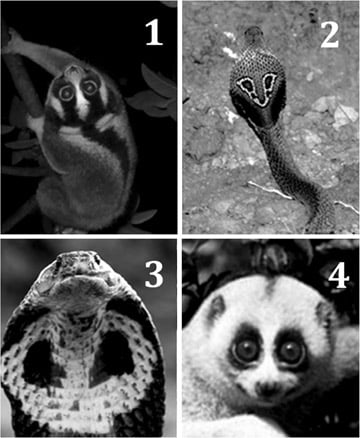
Aside from the venom, there are other unique, serpentine features of the slow loris that support this hypothesis. When viewed by aerial predators, the long, dark stripe running up the loris’ spine and its facial markings could be mistaken for a cobra, particularly at dusk or dawn. Extra vertebra in the animal’s spine allow it to imitate snake-like movements while intermittently emitting cobra-like hisses. In 1905, John Still first noted the uncanny cobra-like defensive posture, sound and gait of his pet slow loris when it was confronted by a cat.
5. Ecological Importance
Although researchers have yet to fully understand the ecology of slow lorises, the species undoubtedly play an integral part within their respective ecosystems across Asia. Slow lorises are prey for snakes, eagles, hawks, felines and, occasionally, orangutans. Slow lorises consume insects, reptiles, and even larger prey, such as birds and tarsiers. The species therefore serve an important role within the food chain, carrying out effective population control and maintaining a balance between species populations within their ecosystems.
Slow lorises have also been known to contribute to pollination, transferring pollen between flowers when extracting nectar. Occasionally consuming fruit as well, slow lorises further assist with the propagation of plants by depositing seeds through their faeces.
6. Threats
Among the world’s 25 most endangered primates, the Javan slow loris has suffered a population decline of at least 80% over the past three generations, or 24 years. Classified as Critically Endangered by the International Union for Conservation of Nature (IUCN) Red List since 2013, surveys have indicated that the species persists at very low densities in unsuitable, fragmented habitats. The animal’s characteristically doe-eyed complexion has sadly proven to be its demise, as slow lorises are a popular target for the illicit exotic pet trade. Decades of rampant deforestation, environmental degradation and infrastructural development in Indonesia have further facilitated poaching, and have rendered the species vulnerable to increased predation. It is estimated that less than 20% of suitable habitat remains for the Javan slow loris, and a mere 17% of the species’ potential distribution lies within current protected area networks.
Of the Indonesian slow lorises, the Javan slow loris suffers a significantly greater threat from anthropogenic activity. Java is one of the world’s most densely populated areas with a history of intensive land use and inadequate environmental protections. With a population of 145 million on an island the size of New York state, agricultural expansion, urban encroachment and the extraction of tropical hardwoods have fuelled decades of deforestation in order to provide sustenance and a source of income to the island’s inhabitants. As a result, only 7% of Java’s original forest cover remains, and lowland rainforests have been largely decimated. Remaining forested areas are surrounded by several kilometres of intensely modified, unsuitable habitat, which effectively confine remnant slow loris populations to isolated localities with limited resources. As Professor Nekaris states, “It’s a miracle there are any [lorises] at all”. Javan slow lorises monitored by Nekaris and her team inhabit human-dominated landscapes, in hedgerows between tea, coffee and tomato fields. Lacking forest connectivity, lorises are forced to cross approximately 200 metres of open ground to reach the next group of trees, where they are extremely vulnerable to predation by dogs and humans.
In Cipaganti, West Java, volunteers and conservationists with the Little Fireface Project have further observed the risks that infrastructural developments pose to Javan slow loris populations. The species is accustomed to moving at higher elevations in order to avoid ground predators, and thus slow lorises are often observed crawling across waterlines suspended above open farmland. However, the animal is occasionally seen traversing more dangerous substrate, such as rooftops, electricity cables and chayote plantations. Cases of electrocution, indicated by muscular atrophy and third degree burns, dog attacks, entanglement in plantations, and general wounds are reported by villagers, who often attempt to rescue lorises and take them to the Little Fireface Project field station. In 2022, on the neighbouring island of Sumatra, approximately 3,483 animals suffered from electrocution, 80% of which were slow lorises. Unfortunately, slow lorises that fall victim to electrocution and encounters with dogs are extremely unlikely to survive.
Perhaps the biggest threat to the Javan slow loris is poaching, which is primarily fuelled by the exotic pet trade and, to a lesser extent, folkloric medicinal practices. Slow lorises are one of the most common protected primates found in animal markets in Java, many of which are traded domestically or smuggled internationally to locations such as Japan and the Middle East. Regardless of claims made by pet traders, animals sold on the exotic pet market are almost exclusively poached from the wild as it is notoriously difficult to breed slow lorises in captivity. Due to their non-leaping locomotion, nocturnal disposition, and tendency to freeze when confronted, combined with the rampant habitat destruction that the species suffers in Java, slow lorises are easy to capture.
Once poached, traders will typically cut or remove the animal’s teeth to prevent them from delivering their venomous bite. This incredibly painful procedure is done with nail clippers, wire cutters, or pliers and without anaesthetic. Lacking proper treatment, the process typically results in severe infection or death from blood loss. Many more perish during subsequent transportation, as numerous slow lorises are stuffed into small boxes or sacks with no ventilation, food or water. Combined with the stress of this process, transportation of slow lorises results in a mortality rate of 30% to 90%.
As with all species of wildlife, slow lorises are adapted to fill a specific ecological niche with distinct dietary, environmental and behavioural habits, often travelling long distances at night and displaying territoriality. In captivity, these animals are kept in brightly lit rooms, confined to small cages with other lorises, and are forced to remain active during the day. Unable to express natural behaviours, slow lorises suffer from psychological and emotional trauma, and sustain extensive damage to their large, nocturnal eyes. Owners of slow lorises also fail to meet the species dietary needs, feeding them rice and excessive amounts of fruit. As a result, captive lorises experience an array of health problems, such as diabetes, obesity, malnutrition, tooth decay, metabolic bone disease, pneumonia, and infection.
Excessive handling is also a source of extreme distress and discomfort for captive slow lorises, having been deprived of their natural defensive measures. In 2009, a video of a slow loris being tickled with its hands up in the air was widely circulated on the internet, as most viewers were under the misconception that the animal was enjoying he experience. The cry of a slow loris is ultrasonic, which is too high a frequency for humans to hear. Subsequent videos of slow lorises eating rice balls, bananas and being kept as docile pets resulted in the animal becoming a popular target for the exotic pet trade. In 2013, R&B singer Rihanna tweeted a photograph of herself with a slow loris in Thailand, where the animal is peddled by touts as a photo opportunity for tourists. In 2014, pop singer Lady Gaga attempted to use a slow loris as a prop on the set of a music video, but the idea was subsequently dropped after the singer was bitten by the animal.
Even if confiscated, surrendered or rescued, reintroduction to the wild has proven extremely difficult for slow lorises. Left with fractured or no teeth, damaged eyes, a loss of natural instincts and long-term health issues, many rescued slow lorises are not viable candidates for reintroduction and must remain in sanctuaries for the remainder of their lives. In a two-year study conducted in 2015, 11 healthy radio-collared slow lorises were released back into the wild, however only two were known to have survived.
Lastly, hybridisation poses an additional threat of extinction, not exclusively to the Javan slow loris, but to the wider taxa of slow loris. Some species have been hybridised in zoos, and three species of Indonesian slow lorises have been observed together in animal markets outside Java (N. javaicus, N. coucang, N. menagensis). Due to morphological similarities shared by the species, misidentification is extremely commonplace. Therefore, if released back into the wild (if the animal is injured or ill, it is often rejected at markets), translocated slow lorises may harbour foreign infections or parasites that threaten native populations, or may potentially hybridise. Aside from losing the genetic integrity of wild populations, hybridisation is considered a threat to the survival of species as it can result in outbreeding depression, an accumulation of deleterious variation, and genetic swamping, which can inhibit local adaptation.
You might also like: 10 of the World’s Most Endangered Animals in 2023
7. Conservation Efforts
The Javan slow loris is protected under Indonesian law (No.5 of 1990) and is listed on Appendix I of the Convention on International Trade in Endangered Species of Wild Fauna and Flora (CITES), which prohibits any commercial trade of the species. However, laws in the region are often unenforced by officials and therefore disregarded by dealers, as slow lorises are openly displayed at animal markets among other protected wildlife species. Even if law enforcement officials confiscate a loris, prosecution is rare. Between 2008 and 2013, 190 lorises were confiscated and sent to the Endangered Primate Rescue Centre in Cuc Phuong National Park, Vietnam, yet 81% of the wildlife crimes committed were not prosecuted.
Of greater impact are the conservation actions enacted and supported by wildlife conservation organisations, local populations, researchers, and the wider public, which have proven fundamental for the protection and survival of slow loris species throughout Asia. At the forefront of slow loris conservation efforts is professor Anna Nekaris, a primate conservationist at Oxford Brookes University and founder of the Little Fireface Project. Professor Nekaris has dedicated her life to the protection of these venomous primates, as slow loris conservation lacks the level of funding that is often awarded to widely popular species, such as tigers and orangutans. By using a holistic, multifaceted approach to conservation, issues of poaching and habitat destruction are being addressed in collaboration with local villagers and farmers to reach a more effective, sustainable solution.
As mentioned, deforestation and habitat destruction pose a significant threat to slow lorises in Java, exposing the species to an increased risk of predation. In East Java, the Meru Betiri National Park once represented a potential pilot project in reducing forest degradation, as the 50,000-hectare forest became a designated protected area for conservation in 1972. However, illegal logging activity and encroachment by human settlements resulted in decades of deforestation within the park’s boundaries, as sources of income were limited in the region. In 2019, however, national park officials began working with villagers to create alternative livelihood opportunities in an attempt to save one of the last tropical rainforests in Java. Villagers were taught new skills, invited to cultivate crops, such as corn, avocados, mangos and mushrooms, and provided with the capital, tools and equipment necessary to develop new sources of income. In return, villagers were required to adhere to one condition: to never cut down trees within the forest. Some former loggers, who had been previously apprehended by authorities, were further required to plant new trees. Although the initiative is still in its infancy, the results have been positive thus far. Villagers have demonstrated a willingness to learn and adapt to their new sources of livelihood, despite the decrease in profit compared to illegal logging. To encourage compliance with forest protection measures, education and public awareness campaigns have also been effective in demonstrating the benefits of healthy environments and ecosystems to local populations.
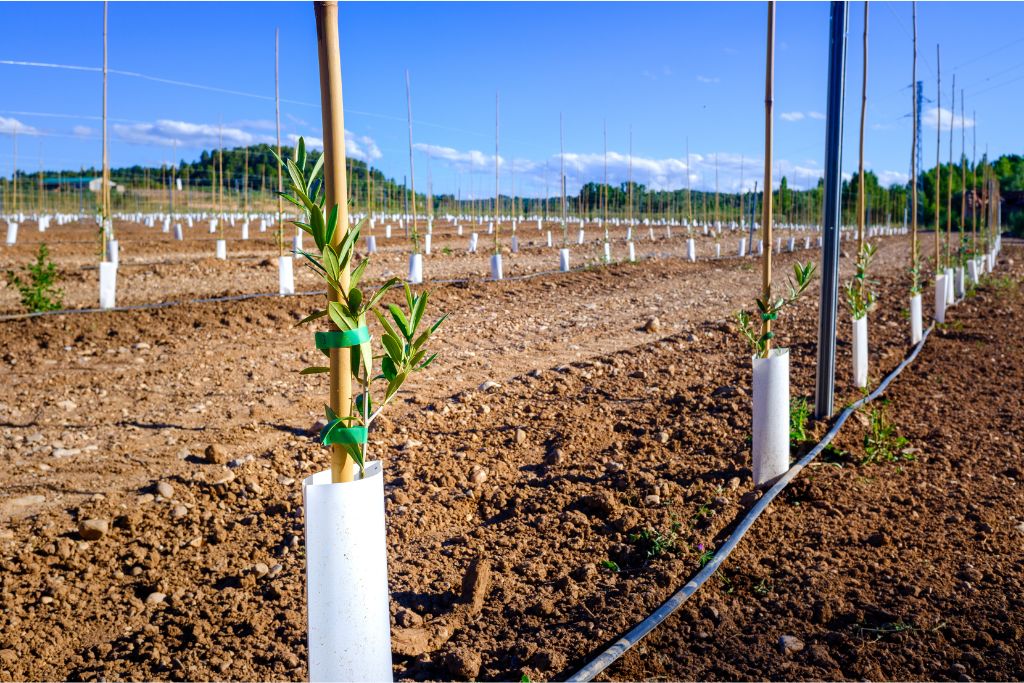
The Little Fireface Project has developed educational materials and programmes across parts of Java, such as children’s books and teacher packs, Nature Clubs, village Pride Days, film nights, and reforestation projects, that explain the ecological importance of slow lorises and the risks of hunting the species. The organisation noted that areas where education and empowerment campaigns are held have become active in establishing patrol and protection measures for resident slow loris populations in their region, having grown fond of the species. Recognising that effective slow loris conservation measures also require the support and cooperation of local farmers, professor Nekaris and her team have focused much of their research on determining what services the species provides to their surrounding ecosystems. Team members have noted that slow lorises serve as effective pest controllers, due to their appetite for insects, and are very good pollinators. It is further theorised that early primates co-evolved with angiosperms, helping to propagate plants and trees that are now valuable to farmers. By demonstrating that slow lorises are invaluable to farming practices in Java, farmers have become increasingly cooperative with conservation efforts.
In December 2019, professor Nekaris published the results of a study into whether building networks of bridges in Java could facilitate the safe passage of slow lorises in absence of connected tree canopies. Nekaris initially installed ladder-like bridges between trees that had been previously utilised in monkey conservation, but the slow lorises did not appear to take to them. She then noted that irrigation pipes used by local farmers, many of which were suspended high above ground level, might offer a better solution as slow lorises had often been observed crossing them. Since the installation of more pipes also stood to benefit farmers, this ensured that the pipes would be maintained regularly. With funding from the People’s Trust for Endangered Species and the Cleveland zoo, Nekaris and her team installed more than 20 water-pipe bridges across key slow loris localities. The initiative has effectively expanded the home ranges of lorises and has allowed the animals to reach previously inaccessible feeding trees, with lorises now observed spending less time travelling, more time feeding, and getting sufficient rest. The newly installed irrigation pipes further reduce the need for slow lorises to travel across farm grounds, plantations, electrical cables, and other dangerous substrate, thereby reducing their risk of harm.
Professor Nekaris has further introduced sustainable farming practices to local villages across Java, such as shade-grown coffee planted in the forest understory, in sustainably fertile soil, and pollinated by insects. Nekaris and her team have assisted local farming communities to pick out trees from a herbarium that not only fix nitrogen in the soil to prevent soil erosion, but that are also beneficial to slow lorises and other wildlife. Achieving a certification from the Wildlife Friendly Enterprise Network and introducing FairTrade and organic practices, which increases the value of local produce, also led to the implementation of a hunting ban on endangered species in 2019, as well as a ban on littering. As environmental awareness spreads throughout Java, slow lorises and other species of endangered wildlife are provided a safer, cleaner habitat in which populations can begin to recover and thrive.
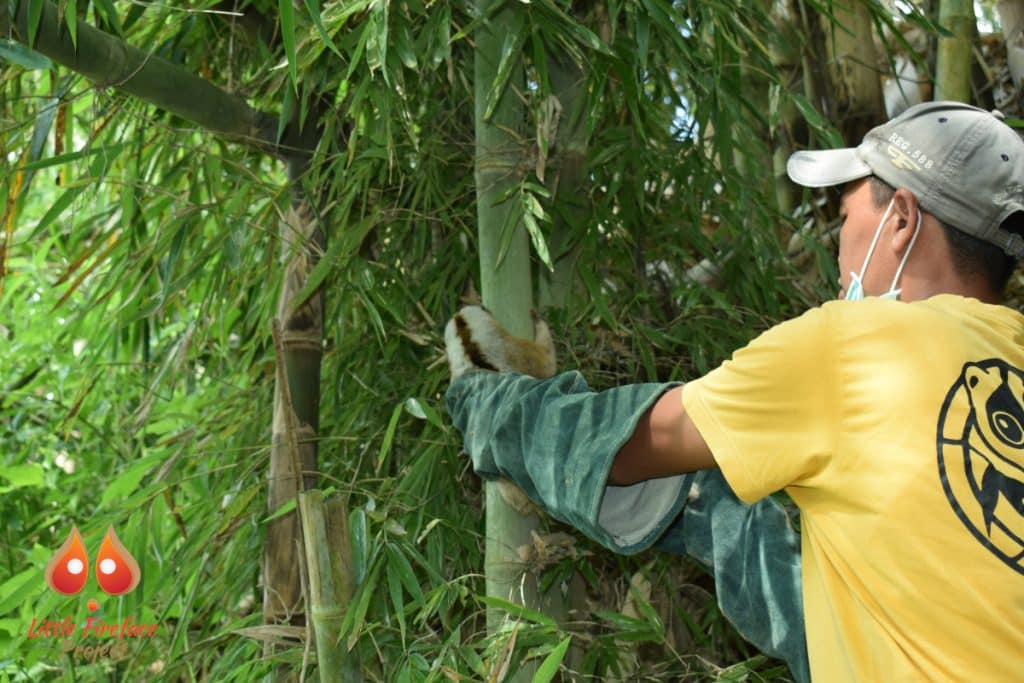
Public awareness campaigns surrounding the exotic pet trade have also aimed at dispelling the widespread misconception that slow lorises make cute, docile pets. In 2015, the International Animal Rescue (IAR) launched a campaign titled “Tickling is Torture”, in an attempt to shed light on the cruelty and suffering that slow lorises experience when poached, traded and sold into a life of captivity. The campaign, aimed at stifling the demand for slow lorises created by online videos, further called on celebrities to ‘drop the props’ if they planned on using endangered wildlife species as objects of entertainment. The IAR has stated that the social media campaign, which called for the public to sign a pledge to put an end to slow loris trafficking, was successful in its aim. After receiving a number of slow lorises that had been confiscated in West Java by the Forest Department (Conservation of Natural Resources) in 2015, the IAR rehabilitated the lorises and successfully released eight individuals into the wild in 2016.
In addition to determining the role that slow lorises play in their ecosystems, professor Nekaris and her team at the Little Fireface Project are also conducting further research into the basic dietary and habitat requirements of the species in an attempt to improve rehabilitation and reintroduction efforts. For example, Nekaris and her team discovered that slow lorises consume a huge amount of tree gum. Equipped with this information, rescue centres and zoos that house slow lorises can ensure that they have the correct resources to cater to the species dietary needs and prevent health issues that are often associated with keeping lorises captive. By monitoring reintroduced lorises, Nekaris also found that 90% didn’t survive as the animals simply ran into the forest until they became exhausted and eventually died of starvation. During a long-term study of slow lorises in the wild, Nekaris noted that perhaps captive lorises were being reintroduced into the wrong habitat, leading the animals to run looking for suitable habitat. Such findings are fundamentally improving how conservation and reintroduction initiatives are planned and executed. Additionally, training workshops for law enforcement officers, CITES officials and rescue centre personnel have been implemented within Java to improve species identification within the wildlife trade.
NGO Spotlight: Little Fireface Project
The Little Fireface Project began under the remit of the Nocturnal Primate Research Group at Oxford Brookes University in 1994, and then became an independent project in 2011. Their mission is to conduct vital research into all lorises, including African pottos, angwantibos, slender lorises and slow lorises, and to contribute to their conservation in the wild and in captivity. Their work has greatly aided in the rehabilitation and reintroduction of slow lorises in many range states, as the research they conduct is thorough and comprehensive, including on topics such as: behavioural ecology, museum studies, genetics, acoustics, taxonomy, conservation education and chemical ecology.
Acknowledging that it is legal to keep slow lorises as pets in some countries, the project aims to educate the public through social media and the internet to ensure that any captive lorises are given an appropriate diet, able to express their natural behaviours as best as possible, and are given an overall good quality of life. However, the organisation importantly sheds light on the cruelty and abuse that often accompanies the exotic pet trade and dispels the widespread misconception that slow lorises make good, docile pets.
In addition to the aforementioned conservation, education and research initiatives that the organisation has successfully undertaken over the past years, professor Anna Nekaris and her team further compel national governments to implement conservation action plans by sharing their research and data on slow loris species residing in each range state. This includes training wildlife officers in species identification, to facilitate the process of confiscation and prosecution. Improving the enforcement of national legislation is a vital element of wildlife conservation that is currently lacking in almost every country where slow lorises are found.
Over years of travels, professor Nekaris has noted that it is becoming more difficult to find lorises in wildlife markets. Rather than openly purchasing the animal on the streets on impulse, buyers are now forced to go through the illegal supply chain, lessening the overall demand for the species. This signifies a huge change for Nekaris, and indicates that the incredible conservation, education and community outreach initiatives that her and her team have implemented are making a difference for the future of slow lorises.
How to Help
- Tourist Tip-Offs. If you are on holiday abroad and see a slow loris being used as a photo opportunity for tourists, do not take your photograph with the animal and inform local authorities of the situation.
- Social Media. If you see a video or photograph of a captive slow loris, or any form of slow loris abuse, don’t click ‘like’ and instead write a comment informing the uploader and any viewers of the reality behind the slow loris pet trade.
- Forest-friendly shopping. When you go to the supermarket next, try to only buy products that are made with certified sustainable palm oil (or no palm oil at all). Palm oil plantations are one of the leading causes of deforestation in Indonesia and Southeast Asia, affecting slow lorises and an array of different primate species.
If you enjoyed this article about the endangered Eastern gorilla, you might also like: Red Pandas: Endangered Animals Spotlight




